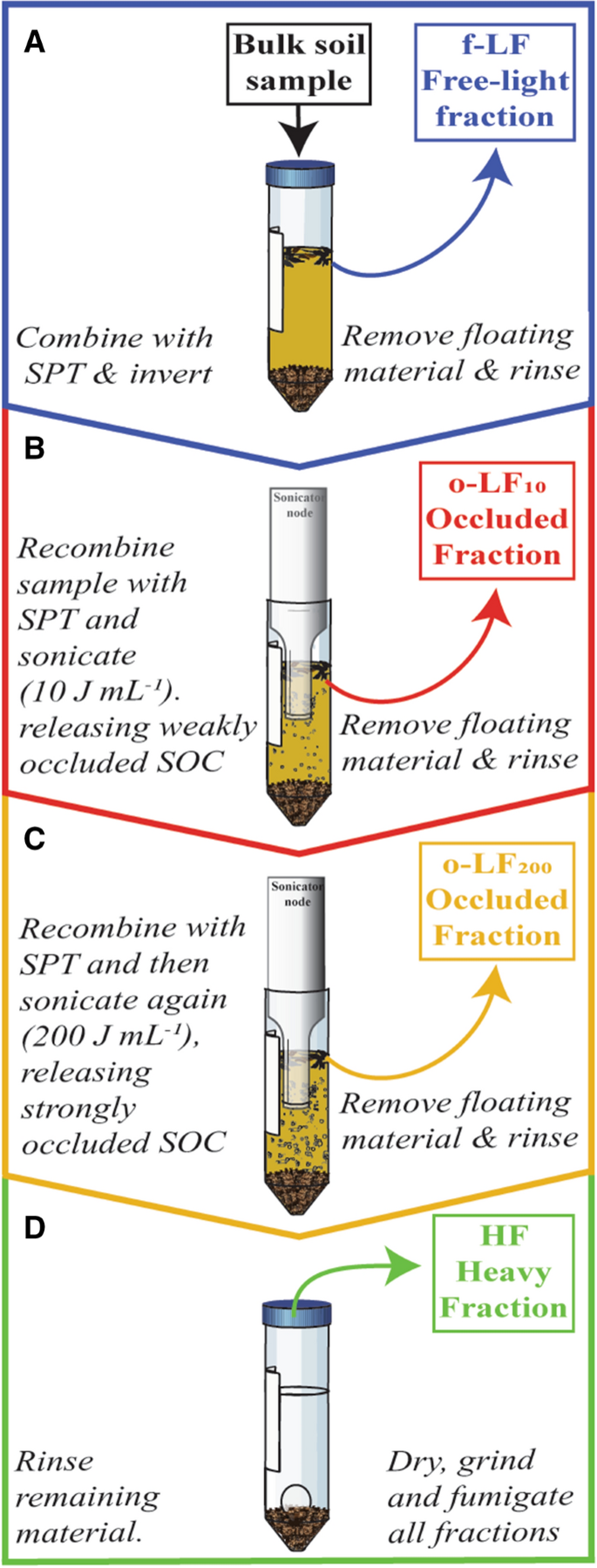April 04, 2021
Evidence Linking Calcium to Increased Organo-Mineral Association in Soils
Calcium content can be linked to a doubling in the mineral-associated organic carbon pool

Representation of methods used to separate soil into its individual components and isolate the organo-mineral fraction.
[Reprinted under a Creative Commons Attribution 4.0 International License (CC BY 4.0) from Rowley, M.C., et al. “Evidence Linking Calcium to Increased Organo-Mineral Association in Soils.” Biogeochemistry 153 (3), 223–241 (2021). DOI: 10.1007/s10533-021-00779-7]
The Science
This study investigates soils from a grassland in Switzerland. Researchers found that carbon content was twice as high in soils with more calcium. The team separated these soils into individual components or pools to determine how this carbon was stored differently in the soil samples. Carbon content was higher in the soils with more calcium because it was trapped on the surface of minerals or rocks. These results highlight the role of calcium in causing carbon to be complexed onto mineral surfaces, and what this mechanism could mean for the global carbon cycle in soils.
The Impact
Soils are a globally important store of carbon. Geochemical properties are emerging as important predictors of carbon in soils. Calcium can play a role in the accumulation of soil organic carbon, but few studies have investigated the exact processes behind this accumulation. This study is one of few that investigates how soil organic carbon is stored in soils with a variation in calcium content.
Summary
Geochemical indicators are emerging as important predictors of soil organic carbon (SOC) dynamics, but evidence concerning the role of calcium (Ca) is scarce. This study investigates the role of Ca prevalence in SOC accumulation by comparing otherwise similar sites with calcium carbonate (CaCO3)-bearing) or without carbonates (CaCO3-free). Researchers measured the SOC content and indicators of organic matter quality (C stable isotope composition [δ13C values] and thermal stability) in bulk soil samples. Researchers then used sequential sonication and density fractionation to separate two occluded pools from free and mineral-associated SOC. The SOC content, mass, and δ13C values were determined in all the fractions. X-ray photoelectron spectroscopy was used to investigate the surface chemistry of selected fractions. The team hypothesized that occlusion would be more prevalent at the CaCO3 -bearing site due to the influence of Ca on aggregation, inhibiting oxidative transformation, and preserving lower δ13C values. Results indicated that bulk SOC content was twice as high in the CaCO3 -bearing profiles, which also had lower bulk δ13C values, and more occluded SOC. Yet, contrary to the researchers’ hypothesis, occlusion only accounted for a small proportion of total SOC (< 10%). Instead, it was the heavy fraction (HF), containing mineral-associated organic C, which accounted for the majority of total SOC and for the lower bulk δ13C values. Overall, an increased Ca prevalence was associated with a near-doubling of mineral-associated SOC content. Future investigations should aim to isolate Ca-mediated complexation processes that increase organo-mineral association and preserve organic matter with lower δ13C values.
Principal Investigator
Margaret Torn
Lawrence Berkeley National Laboratory
mstorn@lbl.gov
Program Manager
Daniel Stover
U.S. Department of Energy, Biological and Environmental Research (SC-33)
Environmental System Science
daniel.stover@science.doe.gov
Funding
This research was funded as part of the Environmental System Science (formerly Terrestrial Ecosystem Sciences) program of the Office of Biological and Environmental Research (BER), within the U.S. Department of Energy (DOE) Office of Science. This research was also supported by the Swiss National Science Foundation (SNSF) located in Canton of Vaud.
References
Rowley, M.C., et al. "Evidence Linking Calcium to Increased Organo-Mineral Association in Soils." Biogeochemistry 153 (3), 223–241 (2021). https://doi.org/10.1007/s10533-021-00779-7.

